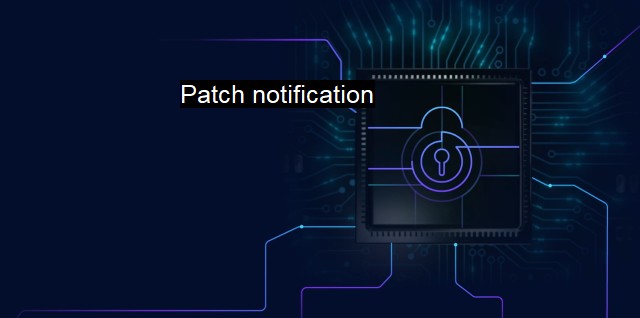What is Patch notification?
The Importance of Patch Notification for Cybersecurity and Antivirus Software: Protecting Your System from Vulnerabilities and Malware Attacks.
Patch notification is an essential element in the cybersecurity ecosystem. It draws attention to updates, modifications, or bug fixes (patches) that aim to mend exposed or vulnerable areas in software or applications, improving their security.Patches are small pieces of software designed to update or fix problems within an operating system or software program. They play an integral role in cybersecurity because they fix vulnerabilities that could potentially be exploited by cybercriminals. Such vulnerabilities often have repercussions varying from a slight degradation of system usability to significant security breaches that could compromise sensitive data.
Patches themselves are not foolproof, and the deployment, installation, or removal of patches can sometimes lead to grave consequences. This elucidates the indispensable role that patch notifications play in forewarning relevant stakeholders about impending modifications. This way, they can strategize and time them in an optimal fashion, ensuring worry-free implementation while negating any untoward systemic implications.
Patch notifications are alerts sent to users of software, informing them that a patch is available to download and install. These notifications are the first line of defense for maintaining a secure digital presence and they keep businesses and individuals updated on the most recent patches that software developers have made available to keep their software safe from cyber-attack.
In antivirus software applications, a patch notification would inform you when the antivirus software has been updated to defend against newly discovered malware or to repair any issues within the software itself. Ensuring an antivirus system is regularly updated and patched is integral to effective cybersecurity protection.
Alternatively, from the software developers' perspective, these notifications can guide their mitigation strategies better. Analyzing various elements such as the extent of patch deployment, its seeming impact, the proportional vulnerability aversion, etc., can lend the developers a value-added vantage point to improvise upon their base designs continually.
From a broader organizational perspective, patch notifications can play a vital role in coherence with their cybersecurity infrastructure. For instance, understanding the precedence of certain patches can help organizations prioritize the execution of notifications, incorporating them optimally within their contingency and operational strategies. Prioritizing crucial vs. non-critical patches helps sort remedial vs. sustenance decisions, promoting a seamless operational narrative that is conducive to both the organization's long-term systemic resilience and its non-negotiable confidentiality requirements toward stakeholders.
Patch notifications also ensure regulation compliance. Increasingly, regulatory laws are determining provisions for up-to-date cybersecurity measures. Regular patches signify a commitment running down that avenue, and patch notifications serve as demonstrable records of compliance, helping breach victim entities as part of their remedial and reactive strategy.
Cyber insurance underwriters rely significantly on not just an organizations' cybersecurity commitments but the avenue translating it to ground reality, patch notifications being a prime example. These underwriters scrutinize for consistent application of patches and notifications, setting premiums accordingly to technological advancements happening around cyberspace.
In a world where cybersecurity threats are always imminent, patch notifications act as watchmen in the world of software applications. They are truly pivotal for technology users and organizations alike, alerting them of necessary fixes, protecting confidential information, closing off potential opportunities that cyber attackers may look to exploit, ensuring regulatory compliance, and helping determine cyber insurance.

Patch notification FAQs
What is patch notification in the context of cybersecurity and antivirus?
Patch notification refers to the process of being alerted when a security patch or update is available for your antivirus software or any other cybersecurity tool you use. It is important to stay updated with the latest patches to protect your system from newly discovered vulnerabilities and potential attacks.Why is patch notification important for cybersecurity?
Patch notification is crucial for cybersecurity because it enables you to keep your antivirus software and other security tools up-to-date, which can help prevent cyberattacks. Cybercriminals are always looking for new vulnerabilities to exploit, and software patches are often released to fix these vulnerabilities. If you don't patch your systems, you risk leaving them open to attack.How can I set up patch notifications for my antivirus software?
The process for setting up patch notifications varies depending on the specific antivirus software you are using. In general, most antivirus software will have an option in their settings to enable automatic updates or notifications when updates are available. Check the settings menu of your antivirus software to configure patch notifications.What should I do when I receive a patch notification for my antivirus software?
When you receive a patch notification for your antivirus software, you should install the patch as soon as possible. Patches are released to fix vulnerabilities and prevent attacks, so delaying the installation of a patch could leave your system exposed. It's also a good idea to back up your data before installing any patches, just in case something goes wrong during the process.| | A | | | B | | | C | | | D | | | E | | | F | | | G | | | H | | | I | | | J | | | K | | | L | | | M | |
| | N | | | O | | | P | | | Q | | | R | | | S | | | T | | | U | | | V | | | W | | | X | | | Y | | | Z | |
| | 1 | | | 2 | | | 3 | | | 4 | | | 7 | | | 8 | | |||||||